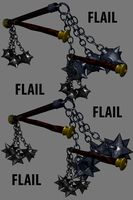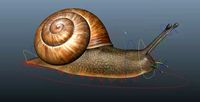Thingiverse

Emerald Flail Snail Monster for Tabletop Games by jawsnoir
by Thingiverse
Last crawled date: 3 years ago
Of all the bizarre creatures that haunt the caves and crevasses of the subterranean world, the flail snail is one of the strangest. As slow for its size as its diminutive cousins, the flail snail fears little from underground predators, thanks to its nigh-impermeable armor and the powerful, mace-like pseudopods that give it its name. Yet the most curious trait of this docile denizen lies is in the singular properties of its shell, which not only defends the creature against magic, but is capable of warping spells and flinging them back at their caster.
Slow and easily avoidable due to their telltale slime trails, flail snails tend to be peaceful unless actively threatened or approached too closely. At these times, the sedately waving tentacles on the creature’s head become an intricately woven blur, the horn-like growths at their tips whistling as they’re flung with terrific force by long strands of muscle. Each swipe of these biological flails is capable of staving in a man’s chest, and though most creatures have plenty of time to retreat, those who press their luck or run afoul of the flail snail’s mucilaginous secretions come out the other side as a red smear on the cavern floor.
The average flail snail stands 8 feet high at the top of its shell and 12 feet long, though the highly elastic nature of its flesh allows it to stretch out much farther. When threatened by an opponent not easily dispatched by its whirling tentacles, the flail snail can retract its entire body into its massive spiral shell, plugging the opening with its four rock-hard flails. These shells are frequently streaked with bright colors in patterns that differ between individuals; older snails tend to have larger shells with more elaborate markings, some of which may appear to resemble runes or symbols. Adult flail snails can weigh several thousand pounds, yet thanks to their slime they still manage to cling perfectly to the stone floors, walls, and even ceilings where they graze, feeding their prodigious bulk on fields of fungus, mold, and vermin. Though they have occasionally been known to consume carrion and the corpses of creatures they kill, this is generally believed to be due to lack of discrimination rather than malice, with the snail simply eating whatever it passes over out of habit.
Physically, flail snails differ from their lesser kindred only in their size, magical shells, and powerful antennae. Movement is achieved via a single enormous foot that takes up most of the underside of the snail’s body and pulls it along by expanding and contracting in muscular ripples aided by slimy secretions. Most of the snail’s day is spent eating with the help of a radula, a long ribbon of tongue studded with thousands of tiny tooth-like structures that act like a rasp, scraping organic matter from the stone and shredding it into pieces for digestion. The constant need to eat leads the snails to migrate frequently, either alone or in slow-moving colonies called routs, and any cavern or dungeon with sufficient organic matter growing on the walls is prime real estate to a flail snail, regardless of what any other inhabitants might think.
Like other slugs and snails, the tentacle-like protrusions on the flail snail’s head are its primary sensory organs, with the top pair sensing light and the lower providing the sense of smell and handling most tactile and fine manipulation duties. Both pairs can be retracted up to the horny growths at the end, and regrow in a month if lost. Even without these sensors, the snail can still move about reasonably well, as its suction with the ground allows it to sense its surroundings via tremors in the rock. This is especially useful since striking out with its powerful flails leads to them being easily damaged in combat.
Though the flail snail’s shell gets the most attention from adventurers and scholars, its slime trail is even more important to its defense and daily life. Like many other gastropods, the flail snail’s slime comes in two types: thin and slippery or thick and sticky. Both are effective at stopping those seeking to invade the snails’ territory, and allow the snails enough suction to climb walls and ceilings without faltering. Mixing the two even allows the snails to create a sticky rope capable of suspending them in the air, lowering themselves or climbing back up with astonishing ease.
Flail snails are born from clutches of up to 30 eggs stuck to cavern walls or buried beneath interesting objects (such as altars or lost treasure hordes). Fully hermaphroditic, flail snails begin their courtship ritual by extruding long, chitinous spears that they stab into each other’s flesh, injecting hormones signaling their intent. They then climb as a pair to the highest point available and begin copulating, lowering their entwined bodies on a massive rope of slime and hanging there for hours or days until mating is finished, at which point they may be forced to gnaw off their own reproductive organs in order to separate. Both individuals then lay egg clutches, and the hatchlings—which start out already shelled, the size of a human’s hand—are raised by the community, with no concept of lineage or heredity. Any flail snail sensing a hatchling in danger instantly rushes to its defense, regardless of personal peril. Matings happen sporadically and may be tied to available food sources, though the fact that flail snails appear to be able to live for hundreds or thousands of years makes reproduction a relatively rare occurrence. Under duress, flail snails have even been observed to retract into their shells and go into long periods of hibernation, making it possible that some of the snails currently active are far older than anyone realizes.
Of course, no discussion of the flail snail’s ecology would be complete without mention of its shell. A magnificent spiral construction several inches thick, the flail snail’s shell grows slowly over time, generated by an organ on the snail’s back known as its mantle, which in turn is fed by metals and minerals scraped in tiny amounts from the stone and ingested as part of the snail’s diet. The wide array of substances used to produce the shell appears to be at least partially responsible for the whorls of color and strange patterns that cover it, though the fact that these often glow after being targeted by magic suggests other factors as well.
Exactly how the shell manages to reflect magic has long baffled scholars, who have put forth numerous theories. Some suggest that it’s due to the ingestion and combination of various magically reactive metals used in the shell’s construction. Others posit that the shell is a focus for the snail’s own magical energies, and that by the whim of gods or evolution the snail has been restricted to using its powers in a retributive manner, an example of perfect natural balance. Still others maintain that the snail’s shell resonates with magic like a bell, acting as a sort of magical tuning fork whose vibration scatters the waves of energy. Perhaps the most compelling argument is that it’s not the shell’s composition that is key, but rather its shape. This theory holds that the flail snail shell has evolved in a perfect golden spiral, a shape long significant to arcanists and engineers, and that this shape manages to draw magic down into its center and then expel it again in a new direction, like a whirlpool or tornado.
Slow and easily avoidable due to their telltale slime trails, flail snails tend to be peaceful unless actively threatened or approached too closely. At these times, the sedately waving tentacles on the creature’s head become an intricately woven blur, the horn-like growths at their tips whistling as they’re flung with terrific force by long strands of muscle. Each swipe of these biological flails is capable of staving in a man’s chest, and though most creatures have plenty of time to retreat, those who press their luck or run afoul of the flail snail’s mucilaginous secretions come out the other side as a red smear on the cavern floor.
The average flail snail stands 8 feet high at the top of its shell and 12 feet long, though the highly elastic nature of its flesh allows it to stretch out much farther. When threatened by an opponent not easily dispatched by its whirling tentacles, the flail snail can retract its entire body into its massive spiral shell, plugging the opening with its four rock-hard flails. These shells are frequently streaked with bright colors in patterns that differ between individuals; older snails tend to have larger shells with more elaborate markings, some of which may appear to resemble runes or symbols. Adult flail snails can weigh several thousand pounds, yet thanks to their slime they still manage to cling perfectly to the stone floors, walls, and even ceilings where they graze, feeding their prodigious bulk on fields of fungus, mold, and vermin. Though they have occasionally been known to consume carrion and the corpses of creatures they kill, this is generally believed to be due to lack of discrimination rather than malice, with the snail simply eating whatever it passes over out of habit.
Physically, flail snails differ from their lesser kindred only in their size, magical shells, and powerful antennae. Movement is achieved via a single enormous foot that takes up most of the underside of the snail’s body and pulls it along by expanding and contracting in muscular ripples aided by slimy secretions. Most of the snail’s day is spent eating with the help of a radula, a long ribbon of tongue studded with thousands of tiny tooth-like structures that act like a rasp, scraping organic matter from the stone and shredding it into pieces for digestion. The constant need to eat leads the snails to migrate frequently, either alone or in slow-moving colonies called routs, and any cavern or dungeon with sufficient organic matter growing on the walls is prime real estate to a flail snail, regardless of what any other inhabitants might think.
Like other slugs and snails, the tentacle-like protrusions on the flail snail’s head are its primary sensory organs, with the top pair sensing light and the lower providing the sense of smell and handling most tactile and fine manipulation duties. Both pairs can be retracted up to the horny growths at the end, and regrow in a month if lost. Even without these sensors, the snail can still move about reasonably well, as its suction with the ground allows it to sense its surroundings via tremors in the rock. This is especially useful since striking out with its powerful flails leads to them being easily damaged in combat.
Though the flail snail’s shell gets the most attention from adventurers and scholars, its slime trail is even more important to its defense and daily life. Like many other gastropods, the flail snail’s slime comes in two types: thin and slippery or thick and sticky. Both are effective at stopping those seeking to invade the snails’ territory, and allow the snails enough suction to climb walls and ceilings without faltering. Mixing the two even allows the snails to create a sticky rope capable of suspending them in the air, lowering themselves or climbing back up with astonishing ease.
Flail snails are born from clutches of up to 30 eggs stuck to cavern walls or buried beneath interesting objects (such as altars or lost treasure hordes). Fully hermaphroditic, flail snails begin their courtship ritual by extruding long, chitinous spears that they stab into each other’s flesh, injecting hormones signaling their intent. They then climb as a pair to the highest point available and begin copulating, lowering their entwined bodies on a massive rope of slime and hanging there for hours or days until mating is finished, at which point they may be forced to gnaw off their own reproductive organs in order to separate. Both individuals then lay egg clutches, and the hatchlings—which start out already shelled, the size of a human’s hand—are raised by the community, with no concept of lineage or heredity. Any flail snail sensing a hatchling in danger instantly rushes to its defense, regardless of personal peril. Matings happen sporadically and may be tied to available food sources, though the fact that flail snails appear to be able to live for hundreds or thousands of years makes reproduction a relatively rare occurrence. Under duress, flail snails have even been observed to retract into their shells and go into long periods of hibernation, making it possible that some of the snails currently active are far older than anyone realizes.
Of course, no discussion of the flail snail’s ecology would be complete without mention of its shell. A magnificent spiral construction several inches thick, the flail snail’s shell grows slowly over time, generated by an organ on the snail’s back known as its mantle, which in turn is fed by metals and minerals scraped in tiny amounts from the stone and ingested as part of the snail’s diet. The wide array of substances used to produce the shell appears to be at least partially responsible for the whorls of color and strange patterns that cover it, though the fact that these often glow after being targeted by magic suggests other factors as well.
Exactly how the shell manages to reflect magic has long baffled scholars, who have put forth numerous theories. Some suggest that it’s due to the ingestion and combination of various magically reactive metals used in the shell’s construction. Others posit that the shell is a focus for the snail’s own magical energies, and that by the whim of gods or evolution the snail has been restricted to using its powers in a retributive manner, an example of perfect natural balance. Still others maintain that the snail’s shell resonates with magic like a bell, acting as a sort of magical tuning fork whose vibration scatters the waves of energy. Perhaps the most compelling argument is that it’s not the shell’s composition that is key, but rather its shape. This theory holds that the flail snail shell has evolved in a perfect golden spiral, a shape long significant to arcanists and engineers, and that this shape manages to draw magic down into its center and then expel it again in a new direction, like a whirlpool or tornado.
Similar models
free3d
free

Creature Snail w spikes on its shell V1
...creature snail w spikes on its shell v1
free3d
creature snail w spikes on its shell v1 printable, low poly model.
cg_trader
free

Snail
...animal gastropod spiral shellfish shell helix jungle invertebrate frog escargot crustacean rasp seafood animals other snail shell
thingiverse
free

Spool Snail by Intentional3D
...lime trail. the holder is designed for 4 cm wide spools and there are two models corresponding to spool diameters of 15 or 25 cm.
cg_trader
$5

low poly alien snail
... poly alien snail
cg trader
low poly alien snail made by blender alien snail scifi sea shell creature animals insect snail shell
3dwarehouse
free

Snail
...snail
3dwarehouse
a snail #animal #component #crawl #creature #eye #nature #nick #shell #sketchycat #snail #soft
grabcad
free

Flail(One-handed )
... flail features the classic flail design of a long wooden handle with a chain connected to its end, which supports a spiked ball.
unity_asset_store
$15

Casual Tiny Slime - Magic knight Pack
...casual tiny slime - magic knight pack asset from jj studio. find this & other creatures options on the unity asset store.
cg_trader
$8

snail 3d model
... lowpoly cartoon girl cartoon boy animals lion cartoon boy cartoon fish cartoon girl cartoon shark fish fish sea lion snail shell
thingiverse
free

flail snail
...ng made visit my instagram or patreon.
insta: www.instagram.com/homunculuscreations/
patreon: www.patreon.com/homunculuscreations
cg_trader
$50

Snail
... |frames| ) render ready! snail caracol caramujo molusco mollusk insect garden shell slow helix aspersa animals other snail shell
Jawsnoir
thingiverse
free

Efeeti Archer by jawsnoir
...jawsnoir
thingiverse
20mm medium sized efreeti archer for pathfinder or other tabletop games. extra spicey archer for your game.
thingiverse
free

Clown Wizard for Table Top Gaming by jawsnoir
...lown wizard for table top gaming by jawsnoir
thingiverse
22mm scale wizard clown with spooky ice cream cone for tabletop gaming.
thingiverse
free

Camel for Tabletop Gaming by jawsnoir
...get within 10 feet. the target must make a dc 13 fortitude save or be sickened for 1d4 rounds. the save dc is constitution-based.
thingiverse
free

War Bull for Tabletop Gaming by jawsnoir
... for warfare, driving them into enemy formations to break the front line or crush foot archers and other lightly armored targets.
thingiverse
free

Old PC Business Card Holder by jawsnoir
...ot;i remember when computers looked like this," tell the world even more by slapping some custom text or logo on the screen.
Flail
3d_ocean
$8

Flail
...ike and a round spike version. include a silver, gold and wood materials and textures. for any question nicomorin2002@homtail.com
turbosquid
$19

Flail
...
royalty free 3d model flail for download as ma, obj, and fbx on turbosquid: 3d models for games, architecture, videos. (1405644)
turbosquid
$25

flail
... available on turbo squid, the world's leading provider of digital 3d models for visualization, films, television, and games.
turbosquid
$20

Flail
... available on turbo squid, the world's leading provider of digital 3d models for visualization, films, television, and games.
turbosquid
$20

flail
... available on turbo squid, the world's leading provider of digital 3d models for visualization, films, television, and games.
turbosquid
$10

flail
... available on turbo squid, the world's leading provider of digital 3d models for visualization, films, television, and games.
turbosquid
$8

Flail
... available on turbo squid, the world's leading provider of digital 3d models for visualization, films, television, and games.
turbosquid
$5

Flail
... available on turbo squid, the world's leading provider of digital 3d models for visualization, films, television, and games.
turbosquid
$2

Flail
... available on turbo squid, the world's leading provider of digital 3d models for visualization, films, television, and games.
turbosquid
$5

Spike Flail
... available on turbo squid, the world's leading provider of digital 3d models for visualization, films, television, and games.
Snail
3d_export
$5

Snail
...snail
3dexport
snail modeling and stylization.
archibase_planet
free

Snail
...snail
archibase planet
snail picturesque element helix
snail - 3d model (*.gsm+*.3ds) for interior 3d visualization.
archibase_planet
free

Snail
...snail
archibase planet
snail helix insect
snail n020408- 3d model (*.gsm+*.3ds) for interior 3d visualization.
archibase_planet
free

Snail
...snail
archibase planet
snail helix cameo-shell
snail - 3d model (*.gsm+*.3ds) for exterior 3d visualization.
3d_ocean
$15

Snail
...u can turn stretchy body on or off . it ’ s work very well for tvc work or any kind of animation project.thanks for your support.
turbosquid
$25

Snail
...nail
turbosquid
royalty free 3d model snail for download as on turbosquid: 3d models for games, architecture, videos. (1257027)
turbosquid
$75

Snail
...l
turbosquid
royalty free 3d model snail for download as obj on turbosquid: 3d models for games, architecture, videos. (1513151)
turbosquid
$15

Snail
...l
turbosquid
royalty free 3d model snail for download as stl on turbosquid: 3d models for games, architecture, videos. (1669262)
turbosquid
$25

snail
...squid
royalty free 3d model snail for download as ma and fbx on turbosquid: 3d models for games, architecture, videos. (1483396)
turbosquid
$3

Snail
...squid
royalty free 3d model snail for download as ma and fbx on turbosquid: 3d models for games, architecture, videos. (1254926)
Tabletop
archibase_planet
free

Tabletop
...tabletop
archibase planet
rostrum platform stage
tabletop lecturn- 3d model for interior 3d visualization.
3ddd
$1

Tabletop Washbasin
...tabletop washbasin
3ddd
tabletop
modern design of tabletop washbasin
3d_export
$5

TABLETOP GREENHOUSE
...tabletop greenhouse
3dexport
tabletop greenhouse with accessories
turbosquid
free

Tabletop Decor
...urbosquid
free 3d model tabletop decor for download as blend on turbosquid: 3d models for games, architecture, videos. (1634208)
3ddd
$1

Mika White Tabletop
...mika white tabletop
3ddd
mika white tabletop ventless ethanol fireplace
turbosquid
$20

tabletop radio
...d model tabletop radio for download as 3ds, max, obj, and fbx on turbosquid: 3d models for games, architecture, videos. (1167277)
turbosquid
free

Tabletop Sign
... available on turbo squid, the world's leading provider of digital 3d models for visualization, films, television, and games.
archive3d
free

Tabletop 3D Model
...odel
archive3d
rostrum platform stage
tabletop lecturn- 3d model for interior 3d visualization.
3ddd
free

Bench Vise Clamp Tabletop
...bench vise clamp tabletop
3ddd
тиски
bench vise clamp tabletop
turbosquid
$10

Ivanhoe Tabletop Lamp
... ivanhoe tabletop lamp for download as max, obj, fbx, and stl on turbosquid: 3d models for games, architecture, videos. (1411186)
Emerald
turbosquid
$19

Emerald
...yalty free 3d model emerald for download as max, obj, and fbx on turbosquid: 3d models for games, architecture, videos. (1291181)
turbosquid
$9

Emerald
... available on turbo squid, the world's leading provider of digital 3d models for visualization, films, television, and games.
turbosquid
$1

Emerald
... available on turbo squid, the world's leading provider of digital 3d models for visualization, films, television, and games.
turbosquid
$1

Emerald
... available on turbo squid, the world's leading provider of digital 3d models for visualization, films, television, and games.
3d_export
free

Emerald
...ds max. rendering v-ray 5. textures often work after rendering, but in this case, it’s better to write that there are no textures
3ddd
$1

Emerald Сhair
...emerald сhair
3ddd
emerald
в архиве есть файл 2012.maxhttp://www.di-gallerie.com/shop/94/desc/emerald-shair
design_connected
free

Emerald Mirror
...emerald mirror
designconnected
free 3d model of emerald mirror by baker designed by pheasant, thomas.
3ddd
$1

emerald
...emerald
3ddd
emrald , cattelan italia
зеркало emrald cattelan italia
turbosquid
$45

Emerald ring
...squid
royalty free 3d model emerald ring for download as 3dm on turbosquid: 3d models for games, architecture, videos. (1198430)
turbosquid
$19

Emerald Ring
...squid
royalty free 3d model emerald ring for download as max on turbosquid: 3d models for games, architecture, videos. (1234448)
Monster
3d_export
$5

monster
...monster
3dexport
very realistic monster
3d_export
free

monster
...monster
3dexport
bloody monster! (looks terrifying)
3d_ocean
$12

Monster
... this code “envatoguest2016” . visit our store high details 3d character model for small monster , useful for animations, movi...
3d_ocean
$15

Monster
...monster
3docean
android game ios java main model monster playdesign
polycount :1118 texture :1024×1024png
3d_ocean
$8

Monster Man
...monster man
3docean
giant monster
monster man software: 3ds max, mental ray.
turbosquid
$60

MONSTER
...turbosquid
royalty free 3d model monster for download as max on turbosquid: 3d models for games, architecture, videos. (1220728)
turbosquid
$60

Monster
...turbosquid
royalty free 3d model monster for download as fbx on turbosquid: 3d models for games, architecture, videos. (1320840)
turbosquid
$19

Monster
...turbosquid
royalty free 3d model monster for download as max on turbosquid: 3d models for games, architecture, videos. (1248452)
turbosquid
$15

Monster
...turbosquid
royalty free 3d model monster for download as max on turbosquid: 3d models for games, architecture, videos. (1293042)
turbosquid
$15

Monster
...turbosquid
royalty free 3d model monster for download as ztl on turbosquid: 3d models for games, architecture, videos. (1417804)
Games
3d_ocean
$4

Games
...games
3docean
3d games models real stick
3d, models, sports, games , trail
turbosquid
$5

Games
...s
turbosquid
royalty free 3d model games for download as skp on turbosquid: 3d models for games, architecture, videos. (1612115)
turbosquid
$25

Game
...of digital 3d models for visualization, films, television, and games ...
turbosquid
$10

Game
...of digital 3d models for visualization, films, television, and games ...
turbosquid
$5

Game
...for download as blend on turbosquid: 3d models for games architecture, videos....
3d_ocean
$7

game place
...game place
3docean
children game game park game place kids play luna park play
for kids game place
3d_export
$14

game character
...game character
3dexport
game character use for gaming
turbosquid
$20

Game Ready Car For Video Games
...e 3d model game ready car for video games for download as fbx on turbosquid: 3d models for games, architecture, videos. (1499375)
3d_ocean
$5

Game fence
...game fence
3docean
fence game
a high quality game ready fence.
3d_ocean
$16

Arcade Game
...tomate button coin computer console fun game gamer gaming joystick machine play side art video game
detailed arcade game machine.
